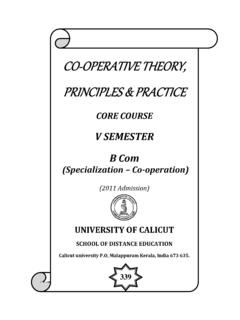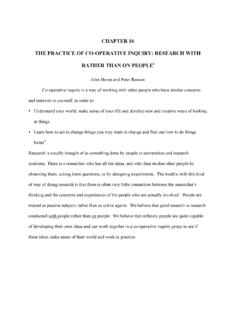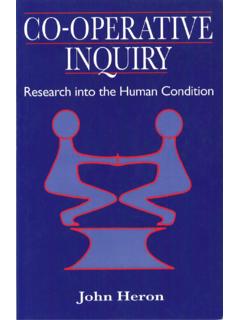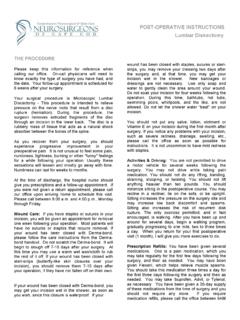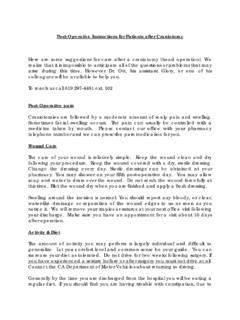Transcription of Post Operative Hip Arthroscopy Rehabilitation …
1 Post Operative Hip Arthroscopy Rehabilitation Protocol Dr. David Hergan Labral Repair with or without FAI Component Initial Joint Protection Guidelines- ( Day 1-4 wks): Joint Protection Patient education o Avoid at all times actively lifting or flexing and rotating hip (thigh) for 2-3 weeks o Assistance from a family member/care taker is important for transitioning positions for the 1st week after surgery o Do not sit in a chair or with hip bent to 90 degrees for greater than 30 minutes for the first 2 weeks to avoid tightness in the front of the hip o Lay on stomach for 2-3 hours/ day to decrease tightness in the front of the hip (patients with low back pain may have to modify position) Weight bearing restrictions o FFWB x 3 weeks if no MFx o FFWB x 6 wks if MFx o PT to provide education on foot flat weight bearing (FFWB) with 20 lbs.
2 Of pressure Brace Use o Brace ROM is set at 0 degrees extension and 90 degrees of flexion for walking o Brace may be locked at 0 degrees extension and 0 degrees of flexion for sleeping o Brace must be worn at all times the patient is up o Must sleep in brace Post Operative Range of motion restrictions for hip Arthroscopy o Flexion limited to 90 degrees x 2 wks o Abduction limited to 30 degrees x 2 wks o Internal rotation at 90 degrees flexion limited to 20 degrees x 3wks o External rotation at 90 degrees of flexion limited to 30 degrees x 3 wks o Prone internal rotation and log roll IR- no limits o Prone external rotation limited to 20 degrees x 3 wks o Prone hip extension limited to 0 degrees x 3 wks Post Operative Physical Therapy Guideline o Patient to be seen 1-3x/wk for 12-16 wks.
3 O This protocol is written for the treating physical therapist and is not to substitute as a home exercise program for patients. o The post Operative Rehabilitation is just as important as the surgery itself Please take a hands-on approach to the patient s care utilizing manual therapy techniques to prevent and minimize post Operative scarring and tightness Please emphasize form and control when instructing patients in exercise to prevent compensation and soft tissue irritation from compensatory patterns The protocol serves as a guideline to patient care for the first 12-16 weeks of rehab. Patients may progress through the protocol at different rates, please always use clinical decision making to guide patient care o DO NOT PUSH THOUGH PAIN Phase 1 - Rehabilitation Goals (weeks 1-6)
4 Provide patient with education on initial joint protection to avoid joint and surrounding soft tissue irritation Begin initial passive range of motion within post Operative restrictions Initiate muscle activation and isometrics to prevent atrophy Progress range of motion promoting active range of motion and stretching Emphasize proximal control of hip and pelvis with initial strengthening Initiate return to weight bearing and crutch weaning Normalize gait pattern and gradually increase weight bearing times for function Phase 2 - Rehabilitation Goals (weeks 6-12) Return the patient to community ambulation and stair climbing without pain using a normal reciprocal gait pattern Continue to utilize manual techniques to promote normal muscle firing patterns and prevent soft tissue irritation Progress strengthening exercises from double to single leg Promote advanced strengthening and neuromuscular re-education focusing on distal control for complex movement patterns Progress the patient to phase 3 Rehabilitation with appropriate control and strength for sport specific activities Precautions for Phase 1 - Hip Arthroscopy Rehabilitation Avoid hip flexor tendonitis Avoid irritation of the TFL, glutes medius, ITB.
5 And trochanteric bursa Avoid anterior capsular pain and pinching with range of motion Prevent low back pain and SIJ irritation from compensatory patterns Manage scarring around portal sites and at the anterior and lateral hip Do not push through pain with strengthening or range of motion Precautions for Phase 2 Hip Arthroscopy Rehabilitation Continue to avoid soft tissue irritation and flare ups that delay progression Be aware of increasing activity and strengthening simultaneously to prevent compensation due to fatigue Promote normal movement patterns and prevent compensations with higher level strengthening Do not push through pain Phase 1 - Passive Range of Motion (Week 1-6) Circumduction flex hip to 70 degree and knee to 90 degrees.
6 Slowly move thigh in small circular motion clockwise. Repeat in counter clockwise direction. Avoid rotating hip into ER and IR during the motion. Perform this motion for 5 minutes in each direction. Neutral circumduction- with knee extended slowly abduct the hip to 20 degrees. Move the leg in small circles clockwise then repeat counter clockwise. Perform 30 reps in each direction. Supine hip flexion slowly flex the hip with the knee bent, avoiding any pinch in the anterior hip. You may provide a caudal glide to avoid pinch at 3 wks post op. Perform 30 reps of this motion Supine abduction- Abduct the hip maintaining the hip in neutral rotation and perform 30 reps of this motion. Supine ER Bring hip to 70 degrees of flexion with the knee flexed to 90 degrees.
7 Slowly rotate the foot inward towards the other leg. Perform 30 reps of this motion. Supine IR- Bring the hip to 70 degrees of flexion with the knee flexed to 90 degrees. Slowly rotate the foot outward. Avoid any pinch in the groin or back of hip. Perform 30 reps of this motion. Side lying Flexion- Have patient lie on uninvolved side. Support the leg by holding it above and below the knee. Slowly flex the knee towards the chest maintaining the hip in neutral rotation. Perform 30 reps of this motion. Prone IR- In prone position, flex patients knee to 90 degrees and slowly move the foot to the outside. Perform 30 reps of this motion. Prone ER- In prone position, flex patients knee to 90 degrees and slowly move the foot to the inside towards back of other knee.
8 Avoid anterior hip pain. Perform 30 reps of this motion. Prone extension In prone, flex the patients knee to 90 degrees. Grasp the anterior aspect of the patient s knee. Stabilize pelvis with opposite hand and slowly extend the hip. Perform 30 reps of this motion. Prone on elbows or press ups- Have the patient lie prone and slowly extend the lumbar spine by propping on their elbows. The patient may progress to prone press-ups as tolerated to stretch the hip flexors. Perform 2 sets of 10 repetitions. Quadruped rocking- The patient assumes a hands and knees position. Keeping pelvis level and back flat, slowly rock forward and backwards from hands back to knees. Once the range of motions restrictions are lifted, the patient may begin to rock backward bringing buttock to heels stretching the posterior hip capsule.
9 Perform 2 sets of 30 repetitions. Half kneeling pelvic tilts- The patients assumes a half kneeling position bearing weight through the involved leg. The patient slowly performs a posterior pelvic tilt gently stretching the front of the hip. Perform 2 sets of 20 repetitions. Phase 1 and 2 - Manual Therapy Treatment Progressions (Week 1-12) Phase 1 Scar massage x 5 minutes o Incision portals begin post op day 2 wk 3 Soft tissue mobilization x 20 30 minutes o Begin Post op day 4 wk 10-12 o Begin with superficial techniques to target superficial fascia initially o Progress depth of soft tissue mobilization using techniques such as deep tissue massage, effleurage, pettrissage, strumming, perpendicular deformation, and release techniques o The use of mobilization with active and passive movement in very effective with this patient population (ART, functional mobilization etc.)
10 O Anterior Hip flexors (Psoas, Iliacus, and Iliopsoas tendon) TFL Rectus femoris Inguinal ligament Sartorius o Lateral ITB Gluteus medius (all fibers, especially anterior) Iliac crest and ASIS Quadratus lumborum o Medial Adductor group Medial hamstrings Pelvic floor o Posterior Piriformis Glutes medius/minimus/maximus Deep hip ER s (gemellus, quadratus femoris, and obturator internus) Proximal hamstrings Sacral sulcus/PSIS/SIJ Erector spinae Quadratus lumborum Joint Mobilizations (3-12 weeks) o Begin with gentle oscillations for pain grade 1-2 o Caudal glide during flexion may begin week 3 and assist with minimizing pinching during range of motion o Begin posterior glides/inferior glides at week 4 to decrease posterior capsule tightness (may use belt mobilizations in supine and side lying) o Do not stress anterior capsule for 6 weeks post op with joint mobilizations Phase 2 weeks 6-12 Continue to utilize manual therapy, including soft tissue and joint mobilizations, to treat patient specific range of motion limitations and joint tightness.
